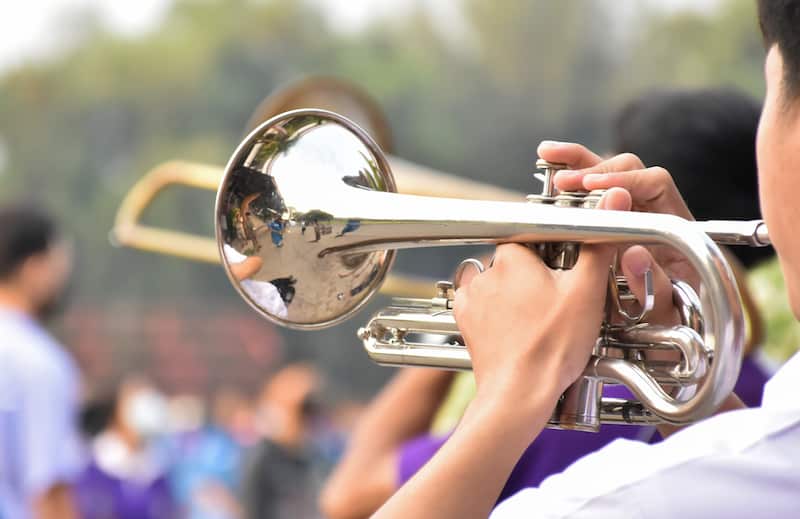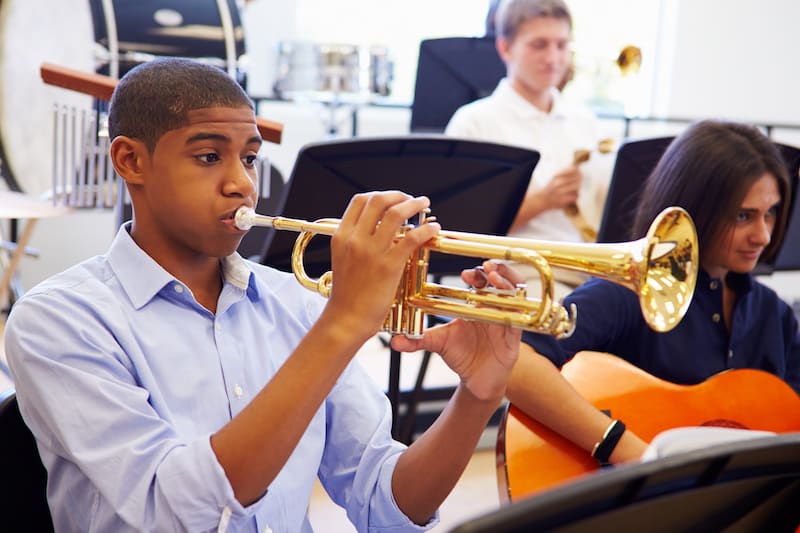The best way to improve your trumpet playing, both immediately and over time, is to warm up properly.
A good warm up routine will not only develop your fundamental skills more efficiently and thoroughly, but it will also help you to get the best out of the rest of your practice time.
This is true of all students, from the absolute beginner to the world’s best musicians – the best players are the ones who warm up correctly!
Why Do We Need to Warm Up?

Before we get into specifics, it’s worth thinking about why we need to warm up before a practice session or performance, and what we expect to get out of a warm-up routine.
Firstly, warming up is important to stretch the muscles we use to play and avoid injury, just as athletes warm-up before a race or event. For trumpet players, it’s easy to hurt the muscles in your face and lips if you try to play too high or loud without warming up properly.
Secondly, warm-up exercises are a really useful way to develop good habits, and it’s these good habits that help us become better players.
We can use warm ups to cover all the physical and technical areas of playing, from posture and breathing to finger technique and high notes.
It’s much easier to focus on these areas in warm-ups, which are designed to be simple, focused, and repeated a lot! When we come to play other pieces of music, they seem easier to play because we already have the techniques in place from our warm ups.
What to Include in a Warm Up Routine
As we noted earlier, warm ups can cover all the physical and technical areas of our playing, so it’s a good idea to touch on all these areas in your warm-up routine, to make sure they’re all being developed.
Here’s an example of the areas you might want to cover in a warm-up routine:
- Posture
- Breathing and breath control
- Note production/tone
- Intervals (moving between notes)
- Articulation (tonguing and slurring)
- Fingering
- Dynamics
It seems like a lot, but some exercises will cover more than one area at once. When you get in the habit of warming up, you’ll get used to these various exercises.
Posture
The first thing to think about when practicing is your posture, how you stand or sit as you hold the trumpet and play.
Posture affects how well we are able to breathe deeply, and also the ability of the right-hand fingers to move the valves quickly, so it will make a big difference to your playing if you can develop good posture.
If you are standing, make sure your feet are straight and roughly shoulder-width apart, and that your knees are relaxed and not locked.
If you are sitting down, sit towards the front of the chair so that your feet are planted flat on the floor. Make sure you have a chair that supports your weight fully – a sofa or armchair is not good for practicing!
Next, straighten your back and neck, so that you are standing/sitting tall. It might help to imagine a string coming out the top of your head and pulling you up like a puppet – it sounds very strange, but it does work!
Finally, relax your shoulders. It’s easy for them to get hunched or tense when you straighten your back, but keeping them relaxed helps our breathing and avoids the build-up of muscle tension.
One final warm-up that helps to get us in good posture – take a deep breath in, and lift up your arms at the same time. Hold the pose, and then drop your arms while still holding your breath.
Take note of your posture, particularly how the ribcage is lifted and expanded. Then breathe out while holding the same posture as much as possible.
Keeping this ‘big’ torso position will also help with breathing as you start to play.
Breathing

Long, deep breaths are key to producing a good, controlled sound on the trumpet. So we need to practice doing that!
It’s a good idea to use a metronome (like our free online metronome here) set at 60 beats per minute or the second hand of a watch or clock to help time these exercises.
It’s amazing how much our counting can speed up once we start running out of breath!
You can start by breathing in for four beats and out for four beats. Try to completely fill up on the in-breath and get rid of absolutely all your air on the out-breath.
Take note of how your stomach expands as you breathe in and squeezes in as you breathe out. Keep your throat relaxed and wide, the same shape as when you yawn (you can try having a nice big yawn to practice that, too!)
Do that a few times, going straight from each repetition to the next.
Then try varying the length of the in-breath and out-breath, like in this series of exercises:
- 4 beats in 4 beats out
- 3 beats in 8 beats out
- 2 beats in 12 beats out
- 1 beat in 16 beats out
For each exercise, we’re making the in-breath shorter and the out-breath longer, which reflects more closely the patterns we’ll use in a piece – a short intake followed by a longer phrase in which we have to push air through the trumpet.
Over time, you can vary the numbers, both to push yourself to longer breaths out, and also to stop yourself from getting bored!
Note Production and Tone
Now it’s time to play some notes! We’re going to start with something very close to the breathing exercises above, but with a long note on the out-breath.
Choose a comfortable note – for example, low C or the G in the treble stave – and take a deep breath before holding that note at a comfortable dynamic for as long as you can.
Listen to the sound as you play. The note shouldn’t change volume or pitch – no wobbling – and should sound as beautiful, rich, and full as you can make it. To do this, you’ll need a strong and steady stream of air.
If you’re struggling, make sure you’re taking a full breath in, keeping your shoulders, neck, and face relaxed, and pushing lots of air through the instrument.
You should practice long notes over the whole of your range, however big or small that is. You could use the notes of a familiar scale (it doesn’t always have to be C major), or jump around to test your ability to pitch different notes.
Intervals, Articulation and Dynamics
Jumping around the range of the trumpet is an important skill to practice and use in pieces. We want to be able to play big leaps between notes as easily as notes that are right next to each other.
One way to do this is by practicing arpeggios, as these involve moving around the range of the instrument. Here’s an example of an arpeggio exercise:
Take a deep breath at the start, and after each pause. You’re going to change the position of your tongue as you go up and down – think ‘tee’ as you go up, and ‘tah’ as you go down to help change note.
You can practice these exercises tongue or slurred, and at different dynamics, as in the example above. Try to make these variations sound as different from each other as possible – very strong accents, or completely smooth slurs, big strong forte (loud) sounds, and tiny whispering piano (soft) sounds.
You could also extend this further by practicing in different keys, moving up and down in semitones, or in fifths.
Vocalize exercises and lip slurs are other common types of exercises used to practice moving between notes.
Vocalizes are slow exercises that help us to work on smooth transitions between notes. Lip slurs are exercises that move between notes with the same fingering, helping us focus on the tongue and breath movements that change the pitch.
There are lots of books full of these exercises, starting relatively simply and becoming very advanced indeed!
- Editions Bim (Publisher)
Tongue and Fingers
We also need to warm up our tongue to help us start notes precisely and to play repeated notes quickly.
Scales are a helpful way to work on these skills. We can play through a scale repeating each note to the same rhythm to work on articulation of repeated notes, listening carefully to make sure every note sounds clean and clear:
Playing scales quickly while tonguing each note is also a really good way of working on your ability to press and release the valves quickly with the fingers of your right hand.
Listen carefully to make sure that your tongue and fingers are moving at exactly the same time so that there aren’t any smudged notes.
Here’s a good exercise for this:
You can also do this exercise slurred to work just on the fingers. Make sure you are pressing down the valves firmly and releasing them quickly.
More advanced players might also want to work on double- and triple-tonguing in this section of the warm-up, but that’s a topic for another day!
Conclusion
In our warm-ups above, we’ve covered the main areas of trumpet playing by using exercises that work on these different aspects and thinking about what we are aiming to do with each warm-up.
This is really important – playing the exercises doesn’t automatically make you a better playing, but listening and thinking about your sound and how it feels to play each exercise will help you improve more quickly.
You can vary all of these above to work on different bits of your playing, and depending on your level – but hopefully, this has given you some initial ideas and a framework to build on.
Happy practicing, and remember – always warm up!


